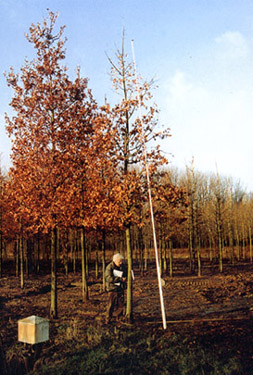 |
The Ruyten Integral Planting Method As part of the visit to see the preparations for Floriade 2002 we visited a 25-acre site close by, where an experimental planting funded by the Dutch nursery sector and the Province of Noord-Holland was begun in 1999. |
|||
|
A cost-saving alternative technique for landscaping in public parks will be presented on the occasion of the Floriade 2002 in Haarlemmermeer near Amsterdam. For this project a recreational area covering 10 hectares was established in the spring of 1999. It represents a joint initiative sponsored by the Dutch nursery sector and the Province of Noord-Holland. The spacious recreational area of Prins Bernhardbos was laid out within two months using the "Ruyten Integral Planting Method" developed by Frits Ruyten of the landscape architecture bureau "Integralis" in Venray, Netherlands. In contrast with the traditional system which uses "stayers and leavers" (overplanting with the knowledge that many will be thinned out later), the integral planting method uses relatively large trees and shrubs. The shrubs are planted sufficiently far apart to avoid the necessity of thinning in later years. A lower level of maintenance
is required using this method, with an initial ground cover sowing
to suppress weeds. If necessary the ground cover can be mowed once
or twice a year. Due to the size of the newly planted shrubs, these
herbaceous ground-covering plants offer no competition to them.
The "Ruyten Integral Planting Method," for which older and more expensive plant material is used, has a higher initial cost than the traditional system. In the long run, however, it is projected that the newer method will prove to be more economical. The maintenance costs will be lower, there will be no expensive cost for thinning and clearing out the unwanted plants like that of the traditional system, and the recreation area is usable immediately in a natural and harmonious form. The site is also immediately more hospitable to wildlife. It is anticipated that the total cost of the new method will be well under that of the traditional technique within six to eight years. [Editor's note: Anyone involved in public planting will recognise the difficulty of getting funded for maintenance versus the relative ease of raising money for the glamour of a new park planting, which gives this technique an immediate appeal.]
|
||||
